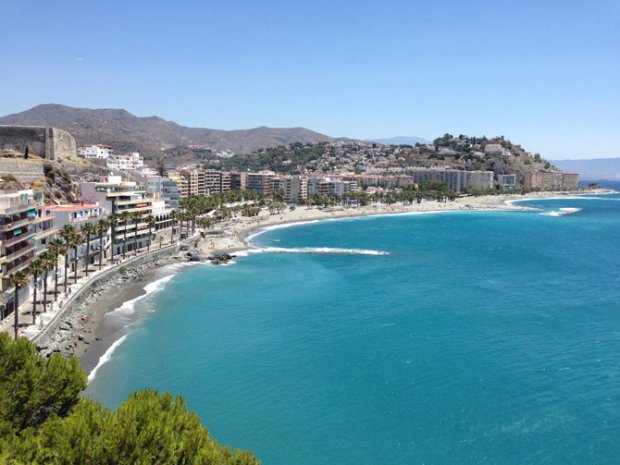Almunecar, Spain

Almunecar, together with its neighbour La Herradura form the tourist capital of the Costa Tropical. The town sits upon a hill at the mouth of two rivers, meandering down to the coast, in the province of Granada in Andalusia.
From here you can almost reach out and touch Africa and its special climate. The town is backed by rugged hills, valleys and agricultural land of olive groves, almond and carob trees.
History
Almunecar was founded by the Phoenicians 3000 years ago and like the rest of the coast been invaded and occupied by the Romans, Moors and re-conquered by the Catholic Monarchs.
There are many monuments and architectural structures that depict the history and occupation of the town.
Around town
The town has medieval steep winding streets that lead to the Plaza de Constitución, where the Town Hall stands, and onto the highest old quarter called Barrio San Miguel and onto the Moorish castle. Most of this area is pedestrianised and residential. Geranium-filled balconies and small sunny plazas line the labryinth of narrow passageways, the town’s archaeological museum is located here.
To the other side of the Plaza de la Constitución, next the Town Hall, a short rise leads up to the The Iglesia Mayor de la Encarnación (the main church) is located on the other side of the Plaza de Constitución, leading away from the town hall. The Casa de Cultura (cultural centre and auditorium) is also located in this district.
The Carrera de la Concepción, once formed a part of the main coast road and is now an attractive, but busy avenue. Here there is a fountain, where the old valley road heads towards Granada and, not far along the road are the excavated remains of part of an aqueduct and important Roman baths.
The Playa Puerta del Mar is Almunecar’s principal beach backed by the palm-lined Paseo del Altillo, there are many banks located along the road. During the summer months parking can be
difficult in the town.
Beaches
Almunecar has 19 kilometres of local coastline, which is diverse with 25 beaches along the coast of Almunecar and La Herradura. Secluded coves, long sandy beaches and the town’s main beachfront with all its amenities and facilities.
There are numerous options for water sports, including diving, the area is said to have some of the best underwater scenery anywhere along the southern coast.
Places to visit
Almunecar has its fair share of cultural and historic attractions, the first and most obvious being the Moorish castle, which was originally built on Roman foundations, however, what still stands is manly from the Arab and Christian occupations.
The archaeological museum, which is located close to the castle; the building was formerly a Roman building, it is known as the Cave of the Seven Palaces, and holds some treasures, including a 3500 Egyptian vase.
The Majuelo Park is a lovely botanical garden, which sits in the shade of the castle. There is a vast array of exotic flora and the centrepiece of the park is the Roman ruins of old fish-salting pits.
The town has paid homage to local characters and resources with dedicated statues and monuments; there are monuments to sailors, fisherman, water, fertility, amongst others.
The area is also dotted with old watchtowers, as the area was infested with pirates. These look outs were built so that they could warn the local villages of certain invasion.
Further afield you can visit the interior of the region, to the Tropical Valley full of rich orchards, which line the Rio Verde (Green River), visiting small inland villages and learning a little of the culture of the area.
Follow the Rio Seco (Dry River) and you will reach the beautiful Peña Escrita Park, where you can go hiking, rambling, horse-riding or just taking in fresh air and magnificent scenery.
Salobreña is another coastal Moorish town, just east of Almunecar. A picturesque white-washed village, definitely worth a visit.
Eating out
Almunecar has a great selection of good quality restaurants, with a mix of traditional and international cuisines.
Climate
The Costa Tropical takes its name from the sub-tropical climate that it enjoys. With warm winters and long hot summers, the average temperature is around 20C.
Source: www.spain-holiday.com
Related posts:








